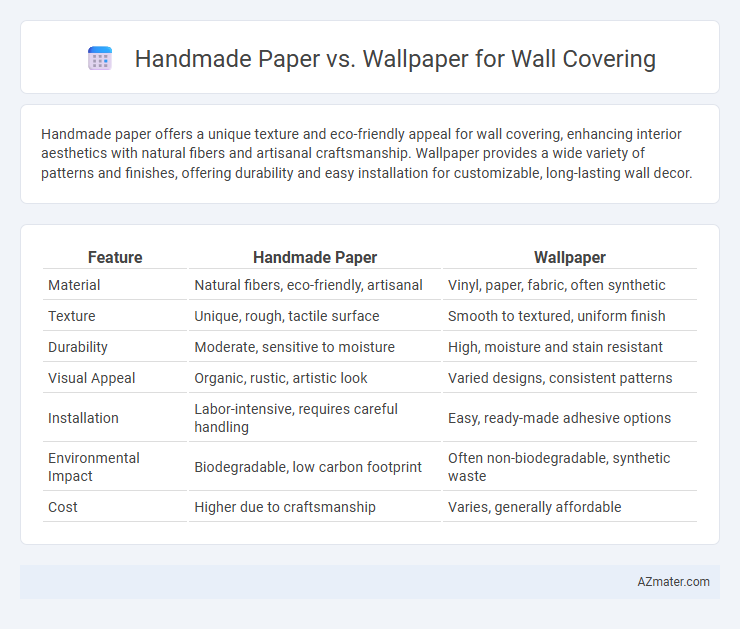Handmade paper offers a unique texture and eco-friendly appeal for wall covering, enhancing interior aesthetics with natural fibers and artisanal craftsmanship. Wallpaper provides a wide variety of patterns and finishes, offering durability and easy installation for customizable, long-lasting wall decor.
Table of Comparison
| Feature | Handmade Paper | Wallpaper |
|---|---|---|
| Material | Natural fibers, eco-friendly, artisanal | Vinyl, paper, fabric, often synthetic |
| Texture | Unique, rough, tactile surface | Smooth to textured, uniform finish |
| Durability | Moderate, sensitive to moisture | High, moisture and stain resistant |
| Visual Appeal | Organic, rustic, artistic look | Varied designs, consistent patterns |
| Installation | Labor-intensive, requires careful handling | Easy, ready-made adhesive options |
| Environmental Impact | Biodegradable, low carbon footprint | Often non-biodegradable, synthetic waste |
| Cost | Higher due to craftsmanship | Varies, generally affordable |
Introduction: Handmade Paper vs Wallpaper
Handmade paper offers a unique, textured aesthetic with natural fibers that bring warmth and organic charm to wall coverings, while wallpaper provides a wide range of patterns, colors, and finishes for versatile interior design. Handmade paper is eco-friendly, biodegradable, and often crafted using sustainable materials, making it ideal for environmentally conscious decor. Wallpaper excels in durability, ease of maintenance, and quick installation, catering to those seeking convenience and extensive design options.
Aesthetic Appeal and Design Versatility
Handmade paper offers unique texture and natural variations that create an artisanal, organic aesthetic, ideal for adding warmth and character to interiors. Wallpaper provides a vast array of patterns, colors, and designs that enable precise customization and bold visual impact suitable for various decor styles. While handmade paper excels in tactile richness and subtle elegance, wallpaper stands out for its extensive design versatility and ease of application.
Material Composition and Origin
Handmade paper for wall covering is crafted from natural fibers such as cotton, hemp, or recycled textile pulp, often produced using traditional artisanal methods originating from regions like India or Japan. In contrast, wallpaper typically consists of layers of paper or vinyl coated with synthetic resins and pigments, manufactured on industrial scales primarily in Western countries. The material composition of handmade paper offers unique texture and environmental benefits, whereas wallpaper emphasizes durability and ease of installation through modern synthetic additives.
Installation Process and Complexity
Handmade paper requires precise alignment and careful handling during installation due to its delicate texture and natural fibers, often needing skilled labor for seamless application. Wallpaper installation typically involves pre-pasted or peel-and-stick options with user-friendly adhesive backing, simplifying the process and making it suitable for DIY projects. The complexity of handmade paper installation is significantly higher compared to wallpaper, which benefits from standardized sizing and patterns designed for easier mounting on various wall surfaces.
Durability and Maintenance Requirements
Handmade paper wall coverings offer unique texture and aesthetic appeal but generally require delicate handling and gentle cleaning due to their vulnerability to moisture and tearing. Wallpaper, particularly vinyl-coated or pre-pasted varieties, provides superior durability, resisting scratches, stains, and humidity, making maintenance simpler through regular wiping or occasional washing. Selecting wallpaper ensures enhanced longevity and lower upkeep, whereas handmade paper demands careful maintenance to preserve its artistic qualities over time.
Environmental Impact and Sustainability
Handmade paper offers a significantly lower environmental impact than traditional wallpaper, as it is typically crafted from recycled materials and natural fibers, reducing waste and chemical use. Wallpaper production often involves synthetic materials, VOC emissions, and non-biodegradable components, leading to greater ecological footprints and landfill waste. Choosing handmade paper supports sustainable practices by promoting biodegradability, minimal processing, and the use of renewable resources in wall covering applications.
Cost Comparison: Handmade Paper vs Wallpaper
Handmade paper wall coverings typically cost more than traditional wallpaper due to the labor-intensive crafting process and use of natural fibers. Wallpaper offers a wider range of price points, from budget-friendly vinyl options to premium textured designs, making it more accessible for various budgets. While handmade paper adds unique texture and eco-friendly appeal, wallpaper provides cost efficiency and easier installation for larger wall areas.
Customization Options for Wall Coverings
Handmade paper offers extensive customization options with unique textures, patterns, and natural fiber blends, allowing for bespoke wall coverings tailored to individual design preferences. Wallpaper provides a wide variety of pre-printed designs, colors, and repeat patterns but is limited in texture variations compared to handcrafted options. Customization in handmade paper enables more organic and artistic finishes, making it ideal for spaces seeking personalized and eco-friendly wall decor.
Best Applications for Each Material
Handmade paper suits accent walls, creating a textured, artisanal feel ideal for bedrooms and cozy reading nooks with moderate humidity levels. Wallpaper excels in high-traffic areas like living rooms and hallways, offering durability, a vast range of patterns, and easy maintenance suitable for spaces prone to moisture fluctuations. Selecting between these materials depends on balancing aesthetic goals with practical requirements like wear resistance and environmental exposure.
Choosing the Right Wall Covering for Your Space
Handmade paper offers a unique texture and eco-friendly appeal, making it ideal for creating a warm, artisanal atmosphere, while wallpaper provides a vast array of patterns, colors, and durability suited for high-traffic areas. Selecting the right wall covering depends on factors such as room function, desired aesthetic, maintenance requirements, and budget constraints. Prioritizing these elements ensures that your choice enhances the space's ambiance while meeting practical needs.

Infographic: Handmade paper vs Wallpaper for Wall covering
 azmater.com
azmater.com